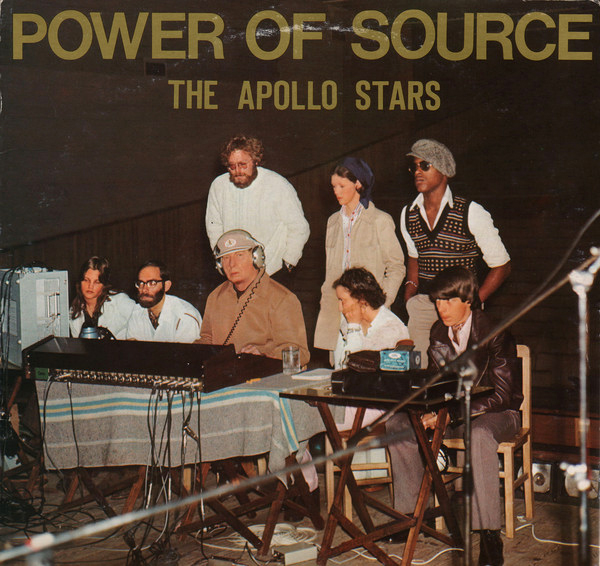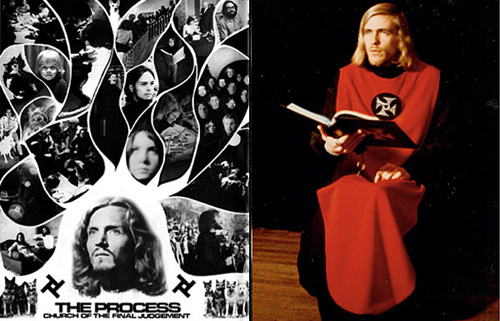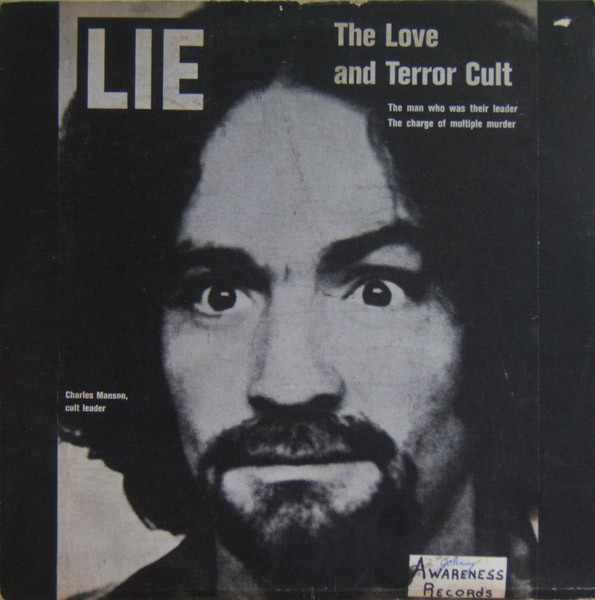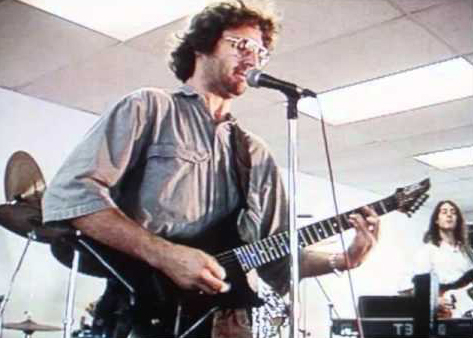
Cult Classics (Part
One)
In The Book of Rites, Confucius says, "Music produces a kind of
pleasure which human nature cannot do without," so it shouldn't surprise
anyone that some religions have banned music, while other start-ups pick it
up as a recruiting tool.
Though there are many who believe popular music is an evil unleashed upon mankind
thanks to the efforts of the Illuminati, the truth is that most tunes simply
stem from a personal relationship with a muse, be it religious or not. Still,
that hasn't stopped quite a few from exploiting or manipulating that idea to
their benefit. Notably, cults are often the greatest offender there.
Newly formed religious sects have always used the power of music to persuade
or entrance - from small Christian church gospels to Krishnas chanting at airports.
While much of the music composed by these strange groups goes unrecorded, there
have been a number of cases where a few faiths, or just their leaders, took
the time to go into a studio, and lay down the grooves God had graced upon them.
Back in 1978, the world was made vividly aware of one of the worst examples
in the dangers of placing your life in the hands of a charismatic guru. Reverend
Jim Jones began his life as a preacher selling, get this, monkeys for the Lord.
In 1956, he started his Peoples Temple Christian Church Full Gospel, in Indianapolis,
which later became known as the People Temple. Always on the move, Jones found
himself in California, where he stayed throughout the 60s and early 70s, though
the church made San Francisco their headquarters. After a bit of bad press,
and foul words from ex-members, Jones moved his 1000 followers to a small village
in Guyana, a country in South America. They called their new home Jonestown.
After more nasty gossip, Congressman Leo Ryan visited to see if all was well.
On November 18, 1978, Jimmy sent a crew to assassinate Ryan, and then led 918
of his devotees to commit suicide by drinking a cyanide-laced sugar drink. The
images seen the next day still defy logic.
Five years before the horror, the Temple was doing well, and even released an
LP on their own Brotherhood Records. Titled He's Able, the twelve track
1973 12" is a collection of traditionals and originals, floating fearlessly
between funk, and your typical Christian gospel.

One of the songs,
"Black Baby" became an underground staple, as "Little Black Angel",
after Death In June transformed four of the Temple's numbers on their But,
What Ends When the Symbols Shatter? album, and later had that version covered
by synth-pop outfit Ladytron.
Scientology is
probably the world's largest cult. They're so big, they once bought the Cult
Awareness Network, just to get themselves off C.A.N.'s list of cults.
Scientology stemmed from the bizarre physio-psychological practices and beliefs
found in sci-fi writer L. Ron Hubbard's 1952 self-help tome Dianetics. After
the failure of his wannabe psychotherapy center (the Dianetics Foundation) he
turned his knowledge of psychological tricks and mental gymnastics - stolen
from the O.T.O. - into his own religion.
Sometime in the 1970s, while floating about the ocean to escape tax evasion
charges, the ex-Navy troublemaker got the idea that music might be a good way
to spread his religious message. Handpicking members of his Sea Org's flagship,
Apollo, the outfit was named The Apollo Stars. After recording their 1974 vinyl
album, Power of Source, the psyched-out funk-jazz act was supposed to
play every stop the trio of ships docked, in hopes of enticing some new recruits.

After a bad reception in Spain and Portugal, where there happened to be a coup, Lafayette decided the band was a bad idea, and scrapped the whole thing.
It didn't deter
him from still getting involved with music, as L. Ron began to pen lyrics, or
sometimes just music, he often handed to some of his most famous musician followers,
like as Edgar Winter...
…and Chick
Corea..
…but also
releasing a few tracks on releases made strictly for Scientologist ears, and
only available via the church's mailorder.
The Process Church
of the Final Judgement is probably the one sect that has, without knowing it,
inspired more music than any other outside mainstream Christianity. From bands
like Throbbing Gristle to Cleveland's Integrity, Skinny Puppy and Funkadelic;
all have released songs, or entire albums, dedicated, or motivated by, this
enigmatic cult.
Formed by two ex-Scientologists, who Hubbard denounced in 1965: Mary Ann MacLean,
and Robert Moor, later changing their surname to the more effective "de
Grimston". The church believed Christ and Satan had shaken hands, and become
buddies, set to bring upon the Apocalypse. Some members worshiped Jehovah or
Christ, and became known as sexless prudes, and others hailed Satan or Lucifer,
and were classified as drug-addled sex fiends. They were said to have inspired
the work of the Son of Sam serial killings, plus other well-known murders, though
no real evidence has surfaced.

The only attempt
the cult made at music was a band formed by one of the cult's high ranking members,
Timothy Wyllie. They recorded a demo tape, but Mary Ann, known as "The
Oracle", was disinterested in her and Robert's words being spread by rock-and-roll,
so she told them to disband. The demo tapes disappeared, and this author has
even contacted Mr. Wyllie to see if any copy of it exists today. Sadly, nothing
could be dug up. Still, there are a few acts that sort of have a "Process
stamp of approval": such as the folk band Changes, who played The Process'
Chicago coffee house due their close philosophic associations, and recorded
tracks in the early 70s, which become known as the Fire of Life demos…
…as well as
modern takes on The Process, with Sabbath Assembly, who in 2010 released Restored
To One, an LP of Process original hymns.
Another who many
have said was inspired by The Process was No Name Maddox - you may know him
as Charles Manson. Collecting the throw-away children of the hippie era, Charlie
(after years of incarceration) had a following of lovely ladies, who coined
themselves "The Family". Though The Family and The Process lived blocks
away from one another for a time, a Manson article appeared in a Process magazine,
and Manson has even admitted knowing of their views in early interviews (just
before his death, he claimed to not have known of The Church of the Final Judgment).
Anyhow, we now know Charles had dreams of stardom, and his gaggle of girls was
mostly an attempt at pimping his way into the music business. Only after one
of his underlings killed a music teacher over a bad drug deal, did Manson's
race war fantasy of Helter Skelter have to go into effect, leading to the Tate-Labianca
slayings.

Just before his
murderous maiden's mayhem, Chuck was brought into the studio by Beach Boys'
Brian Wilson. The tracks would be released by producer Phil Kaufman, after Manson's
sentencing, as the Lie: The Love and Terror Cult LP. One of the songs,
"Cease To Exist", was purchased by The Beach Boys, and reworked as
"Never Learn Not To Love", which Manson never forgave the Wilsons
for. Since then, Manson's music has been covered by The Brian Jonestown Massacre
, Redd Kross, GG Allin, Guns 'N Roses, The Lemonheads, and even actor Crispin
Glover.
As Manson, and
a few of his Family members, sat in prison, many of them on the outside were
singing the praises of Charlie, literally. Recording twice, a handful of the
Manson clan laid down a few of his classics, as well as new ones he had penned
from his cell. Those 1970 recordings became known as the Family Jams
double CD in 1997.
The previously
mentioned underling was one Bobby Beausoleil, who was a musician himself. While
in prison for the supposed Manson-ordered killing of Gary Hinman, Robert scored
the original version of Kenneth Anger's occult short film, Lucifer Rising,
and is still releasing albums today.
Lastly, within
the reach of the Manson camp, is "the other Family", known as the
Fort Hill Community, or The Lyman Family.
In the early 60s, Mel Lyman was a harmonica player in a well-known jug band
(at least by the standards of the jug band scene). Filmmaker Jonas Mekas funded
the publishing of Lyman's two books, Autobiography of A World Savior,
and Mirror At the End of the Road, leading to Lyman amassing a group
of followers. Soon he began to publish Avatar Magazine, which became
your average local newspaper, but slowly changed into Lyman's philosophical
pulpit. While he made the cover of Rolling Stone in 1971, there had always
been a rumor that Manson and Lyman members visited one another's camps to see
what each guru was up to, but this has never been proven. However, in 1973,
some of the Lyman Family staged a bank robbery, where one cult member was killed
in a shootout with police. Strangely, this did nothing to the Fort Hill Community,
and it remained practicing in quiet, even past Mel's death in 1978.

From 1964 until
1971, Lyman played on almost a dozen albums, and was posthumously recognized
by a release of his solo work, and Family recordings, in 2002's retrospective
LP Birth.
Sure, some messianic
groups are left alone to do their religious handiwork, but others are shredded
by those who fear their growing power. One such case is that of David Koresh
and his faith of Branch Davidians.
Koresh, born Vernon Wayne Howell, was a Seventh-Day Adventist, who joined a
splinter group started by George Roden. Over several years Koresh took over
Roden's group, forming his Branch Davidian cult. After tips of child abuse and
gun running, the Bureau of Alcohol, Tobacco and Firearms raided the Davidian
compound. The sweep broke out into an all-out gun battle killing several agents,
as well as church members. Though there was a 51-day standoff, this all was
the precursor to the now infamously televised murder of 80 cult members, including
David Koresh, by the U.S. government.

In 1989, Koresh
thought soft rock would help spread his sermons, self-releasing the cassette
LP, The Music and the Message. The tape made him very few fans, until
after the raid, where it became heavily bootlegged, and found a larger audience
as the 1994 Voice of Fire CD.
Anton LaVey is
someone who has, according to many a conspiracy theorist, had a hand in all
of the above cults, but the fact is the man was just an ex-carnival organist,
who started an occult study group in 1966 that later became The Church of Satan.
Yes, a Manson Family member was a stripper in an early LaVey nudie show, but
there are no other connections between any of the previously mentioned cliques
(besides the Beausoleil/Anger film score).
While Anton LaVey released a 12" LP of The Satanic Mass in 1968,
it wasn't until Amarillo Records released his 1994 10" EP, titled Strange
Music, that the world got to hear the sweet calliope music of Satan's Black
Pope.

With such a wonderful
array of examples, I'll be splitting this piece into two parts, so I'd like
to tell you about a little known odd one last, and it's the story of Synanon.
Originally founded in 1958 as a California drug rehabilitation center, by Charles
E. Dederich, Sr., Synanon turned into a real horror show by the 70s. Chuck loved
going to A.A. meetings, but thought to include all drugs in his version. His
program grew to be successful, soon generating $10 million in profits per year.
Though some of their models have been used as the foundation for certain behavioral
modification theories, many of the Synanon techniques were thought to be cruel
and unusual. By 1970, the group was focused more on spiritual matters, and became
the Church of Synanon, but, by the late 70s, were implicated in all sorts of
thefts, murders, and acts of terrorism (perpetrated by an interior collective
within the church called the "Imperial Marines"). The group was finally
dissolved in 1991 after the Internal Revenue Service sued them for $17 million
in back taxes.
Syanon had a big part in a few jazz musician's lives, as saxophonist Art Pepper
wrote about his stay in his autobiography, Straight Life, and there's
the work of Joe Pass. Considered one of the greatest jazz guitarists of the
20th century, Pass joined a handful of other musicians living at Synanon for
an album in 1962, Sounds of Synanon, on Pacific Jazz Records.

This list is by
no means complete, only covering some of the better known cults that found their
way into musical history. Join me for Part Two, as I delve into another batch
of tunes in the weird world of religious fervor, and devotional piety. There
will be no spiritual surrender.
A. Souto, 2016
BACK TO MUSICA OBSCURA ARTICLE LIST